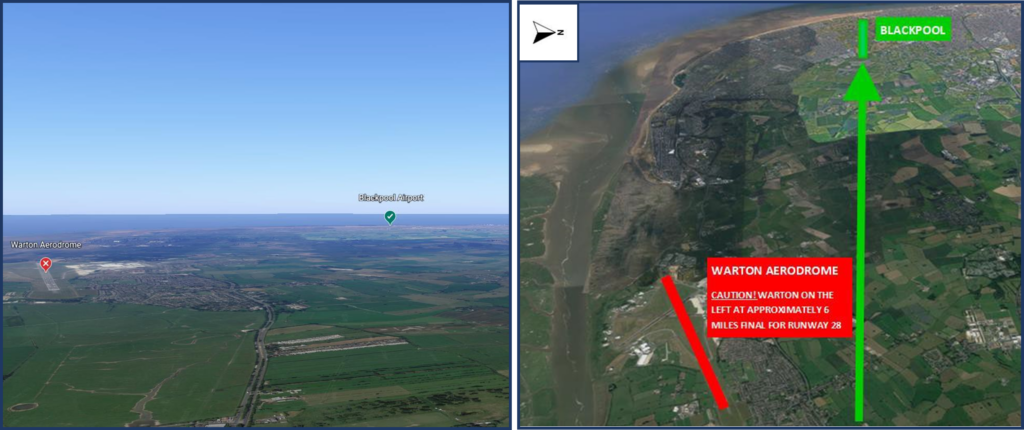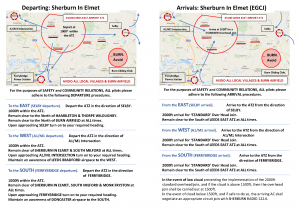An airspace infringement (AI) is the unauthorised entry of an aircraft into notified airspace. This includes controlled airspace, prohibited or restricted airspace, active danger areas, aerodrome traffic zones (ATZ), radio mandatory zones (RMZ) or transponder mandatory zones (TMZ). During the first 9 months of 2022 there have been 1,000 airspace infringement incidents report in UK airspace.
The UK Civil Aviation Authority, the air navigation service providers (ANSP) and General Aviation groups and organisations continue to work in a collaborative manner to raise awareness of the issue and to cut the risk of infringement. This section of the Airspace and Safety Initiative website, provides useful information in methods to prevent airspace infringements.
Tips for avoiding infringements
Think, plan, avoid and enjoy your flight
Key tips to help avoid airspace infringements produced in collaboration with the Airspace Infringement Working Group:
Restrictions of Flying in the UK are established under article 239 of the Air Navigation Order 2016 for the purposes of restricting or prohibiting flying in the public interest by reason of:
- the intended gathering or movement of a large number of persons;
- the intended holding of an aircraft race or contest or of a flying display; or
- national defence or any other reason affecting the public interest.
These restrictions establish airspace structures which fall into 2 categories:
- Restricted Areas (Temporary) or RA(T) which are pre-planned restrictions of flying established for an activity such as an air display or a major event. These are notified using a Mauve Aeronautical Information Circulars (AIC) (published on www.ais.org.uk) and by NOTAM.
- Emergency Restrictions of Flying (ERF) which are established at short notice in response to a major emergency or security incident. These are notified by NOTAM, on the frequency of adjacent air traffic service units and in the form of a sécurité message broadcast on 121.500 MHz and 243.000 MHZ by the Distress and Diversion Cell.
AIS information Line
In addition to the above methods of notification, both types of restrictions are notified on the AIS information Line. As part of your pre-flight preparation, one of the last actions should be to call the Information Line which will give the very latest situation. If you are landing away or flying multiple sectors/flights in a day, the Information Line should be checked just prior to each flight.
The number to call is 08085 354802.
If you are abroad, you can get the same recorded information on +44 (0)1489 887515.
Radiotelephony procedures are contained in CAP413. The following transmitting techniques will help ensure that transmitted speech is clearly and satisfactorily received.
- Before transmitting check that the receiver volume is set at the optimum level and listen out on the frequency to be used to ensure that there will be no interference with a transmission from another station.
- Be familiar with microphone operating techniques and do not turn your head away from it whilst talking or vary the distance between it and your mouth.
- Use a normal conversation tone, speak clearly and distinctly.
- Maintain an even rate of speech not exceeding 100 words per minute. When it is known that elements of the message will be written down by the recipients, speak at a slightly slower rate.
- Maintain the speaking volume at a constant level.
- A slight pause before and after numbers will assist in making them easier to understand.
- Avoid using hesitation sounds such as ‘er’.
- Avoid excessive use of courtesies and entering into non-operational conversations.
- Depress the transmit switch fully before speaking and do not release it until the message is complete. This will ensure that the entire message is transmitted. However, do not depress transmit switch until ready to speak.
- Speak clearly and use standard radiotelephony (RTF) words and phrases wherever possible.
- Messages should not contain more than three specific phrases, comprising a clearance, instruction or pertinent information.
Requesting a Service Outside Controlled Airspace
“(Station) Radar, callsign request (Basic/Traffic/Deconfliction) Service”
When the Controller asks, provide your flight details clearly and concisely:
- Type
- Departure Aerodrome
- Destination Aerodrome
- Position
- Level/Altitude
- Additional details/intentions as necessary (next route point, squawk code.
Read back the type of ATS being given, plus any executive instructions such as Heading, Level, Speed, Squawk, Clearance.
Requesting a Transit of Controlled Airspace
“(Station) Radar, callsign request (Basic/Traffic/Deconfliction) Service and zone transit”
When the Controller asks, provide your flight details clearly and concisely:
- Full callsign
- Aircraft type
- Point of departure and destination
- Present position and altitude
- Whether the request is for a VFR or IFR clearance
- Your requested routing
Read back the clearance, in full, as provided by the ATC Unit.
Transit or Entry of an Aerodrome Traffic Zone (ATZ)
Rule 11 of The Rules of the Air Regulations 2015 states that to fly, take off or land within the ATZ to enable the flight to be conducted safely within that ATZ, the commander of the aircraft:
- must obtain the permission from air traffic unit if the aerodrome has an air traffic control unit
- must obtain information from the flight information centre if the aerodrome provides a flight information service
- must obtain information from the air/ground communication service if the aerodrome provides an air/ground communication service
In addition, the commander must communicate the aircraft’s position and height to the air traffic control unit, the flight information centre or the air/ground communications service unit at the aerodrome (as the case may be) on entering the ATZ and immediately prior to leaving it.
Requesting a Danger Area Crossing Service (DACS)
A Danger Area Crossing Service (DACS) is available for certain DAs. Where this is available the area is prefixed with a dagger symbol. The contact frequencies can be found in the official VFR Chart legend and the availability of their services in the UK AIP ENR 5.1. Pilots should call on the published frequency when approaching a danger area to request a clearance:
“(Station) Radar, callsign request crossing service for Danger Area number”
When asked, provide your flight details clearly and concisely:
- Full callsign
- Aircraft type
- Point of departure and destination
- Present position and altitude
- Your requested routing
Read back the crossing clearance, in full, as provided by the DACS Unit.
If there is no reply from the appropriate nominated service unit that is to be called for a DACS, pilots are advised to assume that the relevant DA is active and remain outside.
- When planning the flight, note the frequencies and any NOTAMS that may apply to the Controlled Airspace you intend to transit. Think about your routing in relation to the active runway alignment. You are much more likely to get a crossing approved over the runway, or to the approach end, if your track is perpendicular to it than aligned with it.
- Once underway and approaching the airspace, listen to the frequency to gain extra information about local activity and the runways in use at airfields within.
- Choose an opportune moment to make your initial call (appending ‘requesting transit clearance’ can be useful).
- On being asked you intentions by ATC keep your reply concise but ensure you include the following:
-
- Full callsign
- Aircraft type
- Point of departure and destination
- Present position and altitude
- Whether the request is for a VFR or IFR clearance
- Your requested routing.
- Read-back the clearance, in full, as provided by the ATC Unit.
- Once entering controlled airspace, acknowledge and confirm the change of service and then comply with ATC instructions.
- Be prepared to have your initial plan adapted, either as part of the initial clearance or possibly while you are transiting the controlled airspace.
- Have a plan B – transit of controlled airspace may not be available.
- The instruction to “Standby”, the issuing of a squawk or the provision of any type of service is not an ATC clearance to enter Controlled Airspace.
- An instruction to ‘Remain Outside Controlled Airspace’ on the first reply from the controller does not mean your transit is already refused, it merely warns you not to enter until a formal clearance is issued.
Local guides
Birmingham Airport Air Traffic has created a dedicated website to help pilots identify the visual reference points (VRPs) around its airspace and help reduce airspace infringements. The website includes information on various VRPs and guidance on how to fly safely near controlled airspace.
Air Traffic Control at Blackpool Airport have created this guide to download:
The content of this guide has been set out to read here:
Mandatory information for Flight Crew flying in to Blackpool
- Blackpool Airport is situated in Class G Airspace.
- We provide either a Procedural Service (IFR ONLY), or Basic We do not have Radar.
- Aircraft under a Procedural service will only be separated from other IFR aircraft participating in a Procedural service. You may see traffic that is not on a Blackpool Service and therefore not identified to you.
- Warton Radar is not established to provide radar services to aircraft inbound to Blackpoool; requests for radar vectors by Warton should be pre-arranged and should not be expected.
- Blackpool Tower and Approach frequency is 955MHz. We will only use 118.405MHz when notified.
- The Direct Arrival ILS DME approach from POLE HILL for Runway 28 is currently unavailable, the ILS DME APPROACH starts at the BPL. In order to expedite your arrival we may be able to offer you the RNP approach via MIFKO, please see current Instrument Approach Chart.
Please ensure you have the correct aerodrome in sight! Do not land at Warton.
- Warton Aerodrome is approximately 6 miles to the South East of Blackpool
- Warton Aerodrome has been mistaken for Blackpool Airport in the past
- The approach paths for the two main instrument runways at Warton (RWY25) and Blackpool (RWY28) cross each other approximately 8nm from Blackpool and 3nm from Warton.
These mages are for info, not navigational use:

Figures 3 & 4 – Google images looking WEST – depicting Warton on the left when on the Runway 28 Approach
Download Wessex LAIT Tips Farnborough Airport



